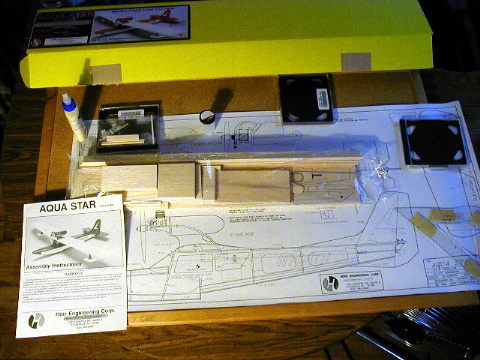
The Herr Aquastar is a small plane designed for .049 to .060 size engines. My plan is to use a Speed 400 6v motor on 7 cells. We will see how that works, but some reading on the web and a few calculations showed it may be feasable. I am hoping to fly this off the snow.

The plane arrived in a rather large box which felt somewhat heavy. I began to have 2nd thoughts about the speed 400 motor. The laser cut parts were neatly packaged in plastic bags. The instuctions are somewhat brief, but do call out the order of the parts to keep one out of trouble. I felt the wood was somewhat heavy and stiff, but I am not an expert having built just a few kits. Still, most parts need several passes with the knife in order to cut them to size. I built the fuselage using the supplied parts according to plan. I then cut out F9 and installed a piece of sheet to provide for a battery tray. I made an extended size hatch and did not use the balsa block as provided with the kit.
I did use the nose block and carving that to shape required just about the same amount of time as building the rest of the fuselage. I think if I were to do another kit, i would try to make a nose that looks like a punt - a tilted transom on the bow. I don't think it would look to bad either. But anyway, the nose block is on there and only needs about 8 hours more sanding. The completed fuselage does not seem too heavy, but it certainly seems very solid. I will not have any fear of landing on the belly on grass.
I built the wing mostly according to plan. The balsa spars were quite stiff, but I read on ezonemag that someone had a wing snap. I added sheer webs to the 1st 3 bays on each side. Compared to the fuselage, the wing seems somewhat fragile. I am hoping that the covering will stiffen up the flex.
I put the motor mount together and then cut it up with a hacksaw making a mount for the speed 400 motor,cutting off a large part of the plywood, but adding a fair amount of sheet. If the mount had small wings and a tail, it might look like a GeeBee. The nose of the mount was a part I had left over from my Microbe kit.
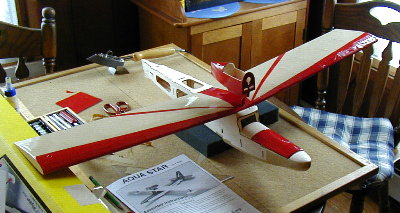
The wing covering went fairly well. I wanted some red on the leading edge and came up with a simple color design that shouldn't add too much weight. Initial balance test at this stage had me thinking the plane would be nose heavy. I started to consider cutting F5 to allow the battery to go back some more, but waited. The wing is heavy on the right side, needing about a penny to allow balance.
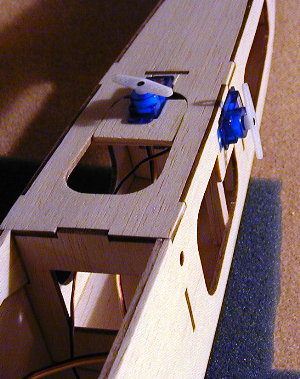
The pushrods in the kit seem to weight more than the HS55 servos I have available. Since the plane seemed nose heavy at this point, I put the servos back as far as the cables conviently allowed. I plan to use some kind of pull pull set up that isn't completely designed yet.
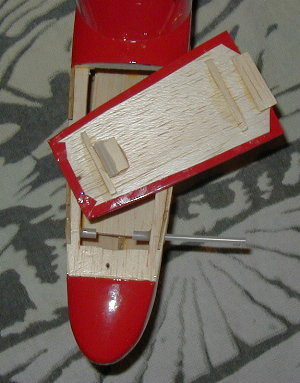
I considered a number of ways to hold the front hatch in place. Initially I had a screw, but that won't be convienent to deal with in the snow with cold fingers. I considered a dowel and elastic, but didn't have a dowel on hand. I came up with an idea of using ny-rod cut in 3 sections like a door hinge. I think this will work well as long as the inner piece stays tight and doesn't drop out in flight. It was easy to set up, the pieces were self aligning.
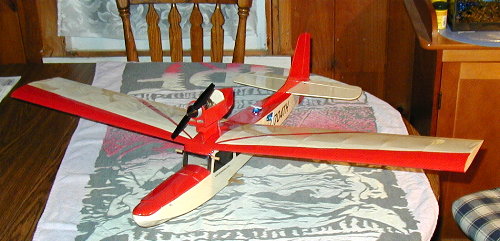
Things are coming together now and we are getting near completion. It's a
neat looking plane. I had some fun with the decals. I cut out the windows for
one side, and was soaking them in some water. They were not softening up as
expected, so I used the time to cut out the other side. While cutting, I
noticed the decals are peel and stick.
After adding the tail pieces and motor, the balance is much more toward the tail and
the battery will need to be up in the nose. With the narrow wing cord, a small
movement of the battery changes the cg alot( relative to 25% cord position ).
The battery will need to be secured well to keep it from shifting even a small
amout.
I am fairly pleased with the weight at this point in time. I have made minor modifications, some adding weight, some removing weight. Major weight reducers have been: not using the wing tip blocks, not using the motor fairing block, not using the pushrods, not using the front hatch block, using small servos, and I hope to use a feather receiver. I have had good luck with the feather in my microbe.
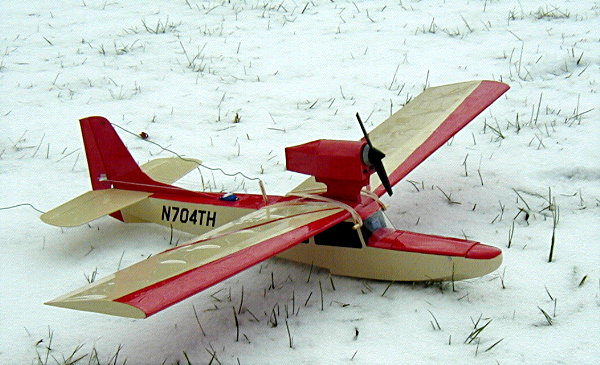
All set for taxi tests in the yard. With a small amount of crusty snow, it looks like I will need the wing tip floats for stability. I am thinking the metacenter is too low ( cg too high ) for good stability with just the hull. The 6x3 prop seems to make a fair amount of noise. First taxi and it glided easily across the snow, I cut the throttle and it kept on sliding across the lawn and down a hill into the woods where it hit a tree. Luckily, no damage that I can see. Rudder response in the snow is not very strong, and my carpet thread pull pull got a bit loose.
The first four flights were on a day that had a bit of wind. Configuration is 6 volt speed 400, 7 500mah batteries, 6x3 direct drive. Initial impressions are the controls are not very responsive, but I am used to aileron planes. It didn't flare very well on landing either. Climbout was not steep but was ok. It flew with about half throttle once in the air.
I have flown this plane a number of times now in different conditions. The initial setup with direct drive worked ok, but I happened to have a multiplex gearbox on hand, 2.33 ratio with a 7x6.5 prop. My calculator shows the following for the two setups I could easily try:
Propeller 6.0 x 3.0 Geared 1.0
Motor Power Prop
Volts Amps Rpm In Out Eff Time Rpm Thrust Speed
7.0 9.1 12532 63.7 38.5 60.4 6.6 12532 10.2 35.6
Propeller 7.0 x 6.5 Geared 2.33
7.0 4.8 15427 33.8 22.7 67.3 12.4 6621 9.8 40.8
This shows the geared setup having a bit more than half the amps and power, but almost as much thrust and also more pitch speed. I modified the motor mount for the geared setup and gave that a try. The performance was about the same with longer flights. What I liked the most though is that the geared setup is much quieter. Takeoff on new powder snow is about 30 to 40 feet. Full up elevator works well to keep the high thrust from pushing the nose down in the snow. Climbout is shallow, but once this plane gets going it flys very well.
Some other random observations: